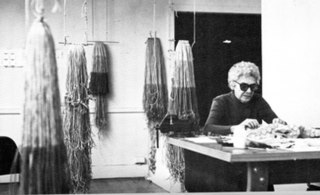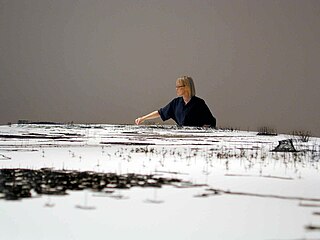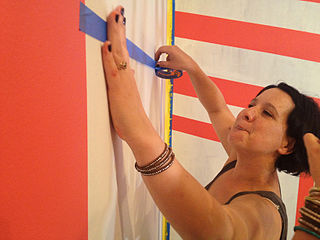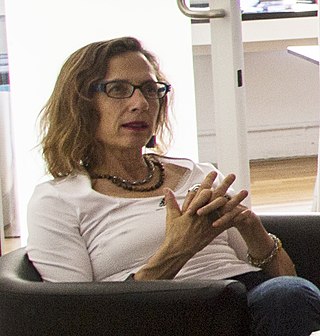Related Research Articles

Judy Chicago is an American feminist artist, art educator, and writer known for her large collaborative art installation pieces about birth and creation images, which examine the role of women in history and culture. During the 1970s, Chicago founded the first feminist art program in the United States at California State University, Fresno which acted as a catalyst for feminist art and art education during the 1970s. Her inclusion in hundreds of publications in various areas of the world showcases her influence in the worldwide art community. Additionally, many of her books have been published in other countries, making her work more accessible to international readers. Chicago's work incorporates a variety of artistic skills, such as needlework, counterbalanced with skills such as welding and pyrotechnics. Chicago's most well known work is The Dinner Party, which is permanently installed in the Elizabeth A. Sackler Center for Feminist Art at the Brooklyn Museum. The Dinner Party celebrates the accomplishments of women throughout history and is widely regarded as the first epic feminist artwork. Other notable art projects by Chicago include International Honor Quilt, Birth Project, Powerplay, and The Holocaust Project. She is represented by Jessica Silverman gallery.

Georgia Totto O'Keeffe was an American modernist painter and draftswoman whose career spanned seven decades and whose work remained largely independent of major art movements. Called the "Mother of American modernism", O'Keeffe gained international recognition for her meticulous paintings of natural forms, particularly flowers and desert-inspired landscapes, which were often drawn from and related to places and environments in which she lived.

Emily Kame Kngwarreye was an Aboriginal Australian artist from the Utopia community in the Northern Territory. After only starting painting as a septuagenarian, Kngwarreye became one of the most prominent and successful artists in the history of Indigenous Australian art.

The University for the Creative Arts is a specialist art and design university in the south of England.

Lenore Tawney was an American artist working in fiber art, collage, assemblage, and drawing. She is considered to be a groundbreaking artist for the elevation of craft processes to fine art status, two communities which were previously mutually exclusive. Tawney was born and raised in an Irish-American family in Lorain, Ohio near Cleveland and later moved to Chicago to start her career. In the 1940's and 50's, she studied art at several different institutions and perfected her craft as a weaver. In 1957, she moved to New York where she maintained a highly successful career into the 1960's. In the 1970's Tawney focused increasingly on her spirituality, but continued to make work until her death.

Claire Zeisler was an American fiber artist who expanded the expressive qualities of knotted and braided threads, pioneering large-scale freestanding sculptures in this medium. Throughout her career Zeisler sought to create "large, strong, single images" with fiber.

Sheila Hicks is an American artist. She is known for her innovative and experimental weavings and sculptural textile art that incorporate distinctive colors, natural materials, and personal narratives.
Minnie Pwerle was an Australian Aboriginal artist. She came from Utopia, Northern Territory, a cattle station in the Sandover area of Central Australia 300 kilometres (190 mi) northeast of Alice Springs.
Richard Herman Driehaus was an American businessman, investor, and philanthropist. He was the founder, chief investment officer, and chairman of the hedge fund, Driehaus Capital Management LLC, based in Chicago.

The Art Institute of Chicago, founded in 1879, is one of the oldest and largest art museums in the United States. It is based in the Art Institute of Chicago Building in Chicago's Grant Park. Its collection, stewarded by 11 curatorial departments, includes works such as Georges Seurat's A Sunday on La Grande Jatte, Pablo Picasso's The Old Guitarist, Edward Hopper's Nighthawks, and Grant Wood's American Gothic. Its permanent collection of nearly 300,000 works of art is augmented by more than 30 special exhibitions mounted yearly that illuminate aspects of the collection and present curatorial and scientific research.

Anne Wilson is a Chicago-based visual artist. Wilson creates sculpture, drawings, Internet projects, photography, performance, and DVD stop motion animations employing table linens, bed sheets, human hair, lace, thread and wire. Her work extends the traditional processes of fiber art to other media. Wilson is a professor in the Department of Fiber and Material Studies at The School of the Art Institute of Chicago.

The Driehaus Architecture Prize, fully named The Richard H. Driehaus Prize at the University of Notre Dame, is a global award to honor a major contributor in the field of contemporary traditional and classical architecture. The Driehaus Prize was conceived as an alternative to the predominantly modernist Pritzker Prize.

Adela Akers was a Spanish-born textile and fiber artist residing in the United States. She was Professor Emeritus at the Tyler School of Art. Her career as an artist spans the "whole history of modern fiber art." Her work is in the Renwick Gallery, the Metropolitan Museum of Art and the Museum of Art and Design. Her papers are at the Archives of American Art.

Clare E. Rojas, also known by stage name Peggy Honeywell, is an American multidisciplinary artist. She is part of the Mission School. Rojas is "known for creating powerful folk-art-inspired tableaus that tackle traditional gender roles." She works in a variety of media, including painting, installations, video, street art, and children's books. Rojas lives in the San Francisco Bay Area.

Claudia Hart is an artist and associate professor in the Department of Film, Video, New Media, Animation at the School of the Art Institute of Chicago, Chicago, Illinois. She has been active as an artist, curator and critic since 1988. She creates virtual representations that take the form of 3D imagery integrated into photography, animated loops and multi-channel animation installations.

Marianne Strengell was an influential Finnish-American Modernist textile designer in the twentieth century. Strengell was a professor at Cranbrook Academy of Art from 1937 to 1942, and she served as department head from 1942 to 1962. She was able to translate hand-woven patterns for mechanized production, and pioneered the use of synthetic fibers.

Althea McNishCM FSCD was an artist from Trinidad who became the first Black British textile designer to earn an international reputation.
Ruth Adler Schnee was a German-born American textile designer and interior designer based in Michigan. Schnee was best known for her modern prints and abstract-patterns of organic and geometric forms. She opened the Ruth Adler-Schnee Design Studio with her spouse Edward Schnee in Detroit, which operated until 1960. The studio produced textiles and later branched off into Adler-Schnee Associates home decor, interiors, and furniture.
Joan Livingstone is an American contemporary artist, educator, curator, and author based in Chicago. She creates sculptural objects, installations, prints, and collages that reference the human body and bodily experience.

Agnes Northrup was an American glass artist. She is best known for her design work for Louis Comfort Tiffany and for work in iridescent glass.
References
- ↑ Lopes, Nicholas (27 February 2017). "Down the Drain". Cooper Hewitt, Smithsonian Design Museum . Archived from the original on 29 September 2023. Retrieved 3 March 2019.
- ↑ "Working on the Failed Utopia" (PDF). Governors State University . 2005. Archived (PDF) from the original on 5 February 2023. Retrieved 7 April 2024.
- 1 2 "Christine Tarkowski - Professor". School of the Art Institute of Chicago . Archived from the original on 7 April 2024. Retrieved 7 April 2024.
- ↑ "Christine Tarkowski." ArtSlant. N.p., n.d. Web. 29 Oct. 2014.
- ↑ "Stacking Logics". Creative Capital . 2001. Archived from the original on 1 December 2023. Retrieved 7 April 2024.
- ↑ "Three Year Report 2005–2007 - Individual Artist Awards" (PDF). The Richard H. Driehaus Foundation . 2008. p. 29. Archived from the original (PDF) on 7 November 2014. Retrieved 29 October 2014.
- ↑ Stoepel, Whitney (13 April 2010). "Christine Tarkowski at The Chicago Cultural Center". Gapers Block . Archived from the original on 11 October 2017. Retrieved 7 April 2024.
- ↑ Snodgrass, Susan (11 September 2010). "Christine Tarkowski". Art in America . Archived from the original on 7 April 2024. Retrieved 29 October 2014.
- ↑ Hixson, Kathryn (2005). "Response to Christine Tarkowski's Working on the failed utopia". In Benites, Cecilia; Lyster, Clare (eds.). 306090 09: Regarding Public Space. 306090. Vol. 09. New York: Princeton Architectural Press. pp. 103–5. ISBN 9781568985442. OCLC 61129653 – via Google Books.
- ↑ "Can't Stop Rock Lobster". Shoot the Lobster. 2012. Archived from the original on 19 March 2023. Retrieved 7 April 2024.